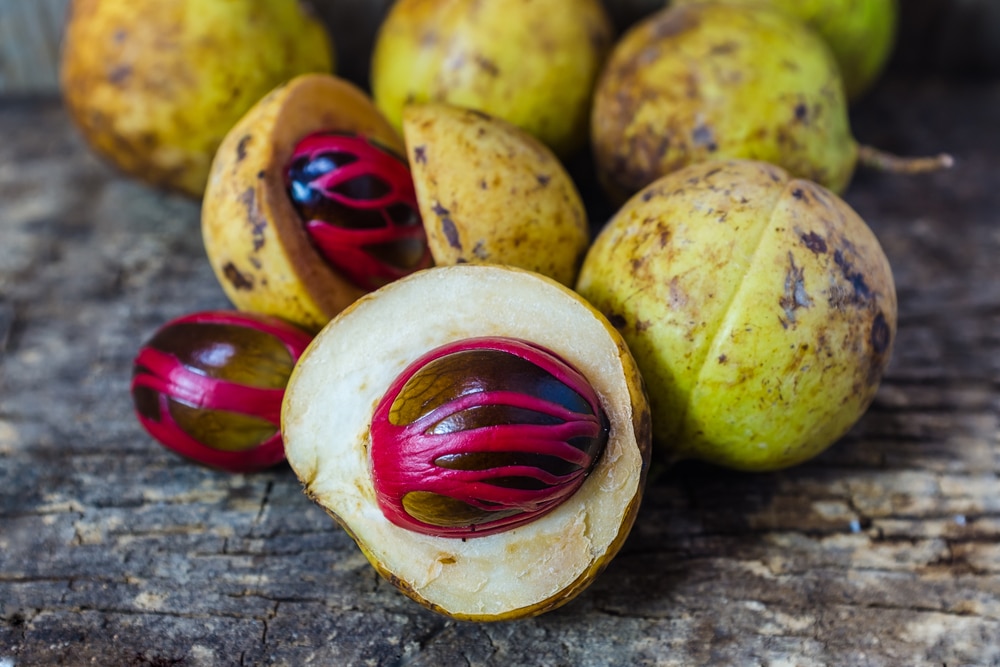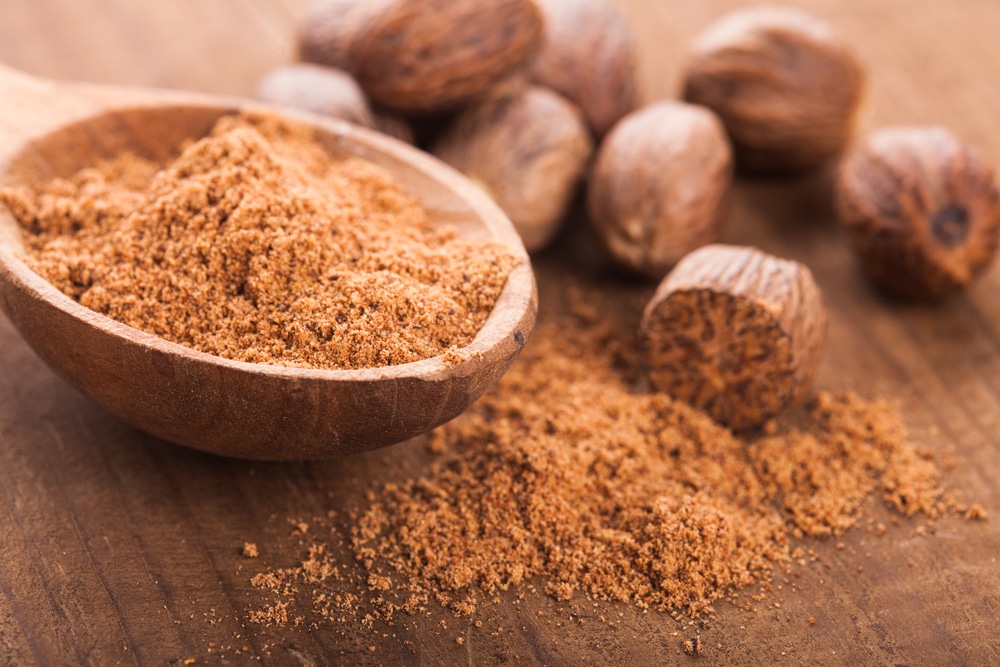Nutmeg is a warm, comforting spice used primarily for baking in desserts. It is also used frequently for cooking savory dishes.
Nutmeg offers a classic flavor that has been cherished throughout cultures and across centuries. Its aroma, versatility, and easy storage make it a welcome staple in kitchens everywhere.
Like many flavoring elements, it’s available in fresh and ground forms.
Difference Between Fresh Nutmeg and Ground Nutmeg
Though there are other minor nuances, the main difference between fresh nutmeg and ground nutmeg is the potency in flavor. With fresh nutmeg, the essence of the spice is preserved for a stronger taste, whereas if you use ground nutmeg, some of the strength will be lost in treatment.
The other differences between fresh and ground nutmeg are the following.
Appearance – Fresh nutmeg looks like a regular nut, while ground nutmeg is in powder form
Smell – Fresh nutmeg has a stronger odor, whereas ground nutmeg offers a more diluted scent
Best use cases – Fresh nutmeg is best used in drinks such as ciders or cocktails, while ground nutmeg is primarily used for baking and cooking.
With all of that said, there are a number of similarities between fresh nutmeg and ground nutmeg.
Flavor – Both fresh and ground nutmeg have the same flavor, although fresh nutmeg is slightly stronger.
Health benefits – Both fresh and ground nutmeg offer the same health benefits.
Shelf life – Both fresh and ground nutmeg have a three to four year shelf life. That said, it’s important that no moisture get into the ground nutmeg powder, or else it will spoil.
Availability – Both fresh and ground nutmeg can be easily found in grocery stores.
Fresh vs Ground Nutmeg Comparison Table
| Fresh Nutmeg | Ground Nutmeg | |
| Appearance | Balled seed (nutmeg fruit) | Fine, copper-colored powder |
| Flavor | Warm, spicy, invigorating | Same but slightly diluted |
| Smell | Pungent, aromatic, festive | Same, but slightly diluted |
| Best use | Wintry cocktails and ciders | Cooking and baking |
| Health benefits | Antioxidant, immune supporter, circulatory booster, pain reliever, sleep agent, digestive regulator, brain health booster | No difference |
| Shelf life | About 3-4 years if stored in an airtight jar in a cool and dry location | Same – very important not to allow moisture into powder |
| Availability | Can be found in specialty markets and some grocery stores | Practically anywhere spices are sold |
Nutmeg is most popular in Indonesian/South Asian cuisine, its natural habitat. The fruit covering – typically removed in Western use – is an element in various jams and candies. Sliced nutmeg makes a great snack on its own.
The versatility of nutmeg is partially due to its ability to complement sweet or savory foods. Though we think of it as a baking element in things like desserts, breads, and cakes, it’s also right at home in savory dishes and many spicy drinks.
Meat seasonings often combine nutmeg with other salty or savory spices for its warm flavor. Soups, stews, and curries use it for complexity in the broth.
Asian dishes like oxtail soup show off its aroma and pack a punch with its gentle yet powerful flavor.
Can You Substitute Fresh Nutmeg for Ground Nutmeg?
It’s possible to substitute fresh nutmeg for ground nutmeg, but the process will take more time. You need to peel the nut, then grate it to the desired consistency before using it in your dish.
Just like garlic, the pre-chopped kind shaves off some prep time in the kitchen but won’t be as strong of a flavor when you cook with it.
Typically, nutmeg substitution goes the other way: a recipe calls for fresh nutmeg, but you only have a jar of powdered nutmeg in the pantry. In this case, the flavor isn’t as pungent, so you’ll need to use more. Start with doubling the measurement in the recipe, then work up to taste if needed.
Fortunately, both fresh and ground nutmeg will keep for several years if preserved correctly. Store in a cool place at room temperature – it is not necessary to refrigerate nutmeg – and absolutely ensure no moisture gets trapped in the storage container.
The flavor is strong enough to sustain over time, even when packaged or jarred.
What is Fresh Nutmeg?

Nutmeg comes from an evergreen tree, classified as myristica fragrans. Grown and cultivated primarily in Indonesia, it’s used in the local cuisine for hundreds of dishes. The seed also produces essential oils, pharmaceuticals, cosmetics, resins for extract, and nutmeg butter.
When we refer to nutmeg for cooking purposes outside of its native habitat, we are talking about the fruit – actually, a seed. This little round ball is packed full of oils and spice to provide the source of so much flavor now shipped and enjoyed all over the world. For example, Japanese curry powder contains high levels of nutmeg as its main spice component.
Fresh nutmeg is available in the spice aisle of most major grocery stores, stored in a small jar. It will appear as round balls that then must be handled properly to extract the flavor for use.
The lacy outer shell of the nutmeg contains a substance called mace. Yellowish-brown in color, it is sweet and spicy when ground and provides a flavor depth to many dishes.
However, nutmeg mace is not the same as the self-defense product that goes by the same name! This latter type is actually a combination of hot pepper juices and aerosol propellants stored in a high-pressure canister for personal protection. You cannot cook with this mixture, nor can you use nutmeg mace for self-defense purposes.
How to Use Fresh Nutmeg
When beginning with a seed, there are limited uses. Most likely, you’ll need to do some hands-on preparation to be able to access nutmeg’s flavor.
Run the seed along a microplane grater to extract the powder. You can also cut, slice, or peel the seed, but grating into a powder is the most common process.
To capture nutmeg’s best quality and most potent flavor, grate the seed directly into the cooking or baking mixture. Grating it will preserve the most oils and flavor before evaporation and imparts most of the spice into the dish instead of leaving residual flavor on storage containers or other utensils.
Step-by-step instructions:
- Procure whole nutmeg and necessary tools: peeler, grater, bowl
- Peel away the outer layer of seed entirely, and discard
- Grate at a 45-degree angle into a dish, only as much as needed to preserve freshness
- Store unused portions until next use.
What is Ground Nutmeg?

Commercially-available nutmeg in a jar is perfectly usable for the exact same flavor and health benefits. The only difference is its potency, which is less than the freshly-ground option.
The substance of ground nutmeg, or nutmeg powder, is the same as a whole nutmeg seed. It is helpful in many cases to have the powder readily accessible, to save cooking time and hassle.
Shave off extra time, tools, and effort with this option, rather than having to deal with whole nutmegs. Bonus: the storage space can be less, as well.
As with any ground spice, some flavor may be sacrificed for convenience. The powder will not have as intense a taste when ground and packaged as if you grind it yourself from the nut, which is due to the nutmeg oils evaporating once the fruit is cut open.
Fresh nutmeg also has a stronger aftertaste than ground nutmeg, as the flavor hasn’t been compromised in processing.
How to Use Ground Nutmeg
Some popular items to add ground nutmeg to are cinnamon rolls, quick breads, and pies. Often, these already include other baking spices, which nutmeg complements well and does not overpower if used cautiously.
There are also numerous wintry drinks that nutmeg suits well, such as mulled cider and eggnog. Specialty cocktails may incorporate nutmeg for a pinch of spice atop their base flavors.
Unlike cinnamon or sugar, which can be added to taste and usually won’t be overpowering, a little goes a long way with ground nutmeg.
Nutmeg is a richer, more pungent flavor, so try a pinch or two first, and don’t go over the measurement detailed in the recipe you’re using. Too much may result in a bitter or soapy taste to your dish.
Nutmeg can usually act as a substitute for other baking spices like cinnamon, ginger paste, allspice, and pumpkin pie spice.
Luckily, the flavor and health benefits don’t decline all that much when using the ground form over fresh nutmeg. As long as you’re careful not to overpower the dish with its potency, nutmeg is a worthwhile addition to dozens of everyday culinary endeavors.






